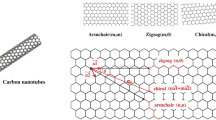Abstract
Carbon nanotubes (CNTs) have been one of the most extensively researched and developed nanomaterials. However, little concern has been placed on their safety. The biological effects of CNTs are believed to differ relative to size and shape. Thus, the relationship between the characteristics of CNTs and their safety needs to be evaluated. In this study, we examined the biological effects of different-sized multi-walled CNTs (MWCNTs) and single-walled CNTs (SWCNTs). Long and thick MWCNTs induced the strongest DNA damage while similar SWCNTs caused little effect. Comparison of inflammatory responses of various types of CNTs found that peritoneal CNT administration of long and thick MWCNTs increased the total cell number in abdominal lavage fluid in mice. These results indicate that long and thick MWCNT, but not short and thin MWCNT, cause DNA damage and severe inflammatory effects. These findings might provide useful information for constructing novel CNTs with safety.



Similar content being viewed by others
References
Sternand, S.T., and S.E. McNeil. 2008. Nanotechnology safety concerns revisited. Toxicol Sci 101: 4–21.
Lacerda, L., A. Bianco, M. Prato, and K. Kostarelos. 2006. Carbon nanotubes as nanomedicines: From toxicology to pharmacology. Adv Drug Deliv Rev 58: 1460–1470.
Tran, P., L. Zhang, and T.J. Webster. 2009. Carbon nanofibers and carbon nanotubes in regenerative medicine. Adv Drug Deliv Rev 61: 1097–1114.
Donaldson, K., R. Aitken, L. Tran, V. Stone, R. Duffin, G. Forrest, and A. Alexander. 2006. Carbon nanotubes: A review of their properties in relation to pulmonary toxicology and workplace safety. Toxicol Sci 92: 5–22.
Maynard, A.D. 2007. Nanotechnology: The next big thing, or much ado about nothing? Ann Occup Hyg 51: 1–12.
Kaneand, A.B., and R.H. Hurt. 2008. Nanotoxicology: The asbestos analogy revisited. Nat Nanotechnol 3: 378–379.
Shvedova, A.A., E.R. Kisin, D. Porter, P. Schulte, V.E. Kagan, B. Fadeel, and V. Castranova. 2009. Mechanisms of pulmonary toxicity and medical applications of carbon nanotubes: Two faces of Janus? Pharmacol Ther 121: 192–204.
Poland, C.A., R. Duffin, I. Kinloch, A. Maynard, W.A. Wallace, A. Seaton, V. Stone, S. Brown, W. Macnee, and K. Donaldson. 2008. Carbon nanotubes introduced into the abdominal cavity of mice show asbestos-like pathogenicity in a pilot study. Nat Nanotechnol 3: 423–428.
Takagi, A., A. Hirose, T. Nishimura, N. Fukumori, A. Ogata, N. Ohashi, S. Kitajima, and J. Kanno. 2008. Induction of mesothelioma in p53+/- mouse by intraperitoneal application of multi-wall carbon nanotube. J Toxicol Sci 33: 105–116.
Sakamoto, Y., D. Nakae, N. Fukumori, K. Tayama, A. Maekawa, K. Imai, A. Hirose, T. Nishimura, N. Ohashi, and A. Ogata. 2009. Induction of mesothelioma by a single intrascrotal administration of multi-wall carbon nanotube in intact male Fischer 344 rats. J Toxicol Sci 34: 65–76.
Shibata, H., Y. Yoshioka, A. Ohkawa, K. Minowa, Y. Mukai, Y. Abe, M. Taniai, T. Nomura, H. Kayamuro, H. Nabeshi, T. Sugita, S. Imai, K. Nagano, T. Yoshikawa, T. Fujita, S. Nakagawa, A. Yamamoto, T. Ohta, T. Hayakawa, T. Mayumi, P. Vandenabeele, B.B. Aggarwal, T. Nakamura, Y. Yamagata, S. Tsunoda, H. Kamada, and Y. Tsutsumi. 2008. Creation and X-ray structure analysis of the tumor necrosis factor receptor-1-selective mutant of a tumor necrosis factor-alpha antagonist. J Biol Chem 283: 998–1007.
Maynard, S., S.H. Schurman, C. Harboe, N.C. de Souza-Pinto, and V.A. Bohr. 2009. Base excision repair of oxidative DNA damage and association with cancer and aging. Carcinogenesis 30: 2–10.
Mossmanand, B.T., and A. Churg. 1998. Mechanisms in the pathogenesis of asbestosis and silicosis. Am J Respir Crit Care Med 157: 1666–1680.
Kampand, D.W., and S.A. Weitzman. 1999. The molecular basis of asbestos induced lung injury. Thorax 54: 638–652.
Pollard, J.W. 2004. Tumour-educated macrophages promote tumour progression and metastasis. Nat Rev Cancer 4: 71–78.
Clevers, H. 2004. At the crossroads of inflammation and cancer. Cell 118: 671–674.
Krelin, Y., E. Voronov, S. Dotan, M. Elkabets, E. Reich, M. Fogel, M. Huszar, Y. Iwakura, S. Segal, C.A. Dinarello, and R.N. Apte. 2007. Interleukin-1beta-driven inflammation promotes the development and invasiveness of chemical carcinogen-induced tumors. Cancer Res 67: 1062–1071.
Dostert, C., V. Petrilli, R. Van Bruggen, C. Steele, B.T. Mossman, and J. Tschopp. 2008. Innate immune activation through Nalp3 inflammasome sensing of asbestos and silica. Science 320: 674–677.
Cassel, S.L., S.C. Eisenbarth, S.S. Iyer, J.J. Sadler, O.R. Colegio, L.A. Tephly, A.B. Carter, P.B. Rothman, R.A. Flavell, and F.S. Sutterwala. 2008. The Nalp3 inflammasome is essential for the development of silicosis. Proc Natl Acad Sci U S A 105: 9035–9040.
Mantovani, A., P. Allavena, A. Sica, and F. Balkwill. 2008. Cancer-related inflammation. Nature 454: 436–444.
Grivennikov, S.I., and M. Karin. 2009. Inflammation and oncogenesis: a vicious connection. Curr Opin Genet Dev. doi:10.1016/j.gde.2009.11.004.
Acknowledgments
This study was supported in part by Grants-in-Aid for Scientific Research from the Ministry of Education, Culture, Sports, Science, and Technology of Japan, and from the Japan Society for the Promotion of Science (JSPS). This study was also supported in part by Health Labor Sciences Research Grants from the Ministry of Health, Labor, and Welfare of Japan; by Health Sciences Research Grants for Research on Health Sciences focusing on Drug Innovation from the Japan Health Sciences Foundation; by a Grant from the Minister of the Environment; and by The Nagai Foundation Tokyo.
Author information
Authors and Affiliations
Corresponding authors
Additional information
Kohei Yamashita and Yasuo Yoshioka contributed equally to this work.
Rights and permissions
About this article
Cite this article
Yamashita, K., Yoshioka, Y., Higashisaka, K. et al. Carbon Nanotubes Elicit DNA Damage and Inflammatory Response Relative to Their Size and Shape. Inflammation 33, 276–280 (2010). https://doi.org/10.1007/s10753-010-9182-7
Published:
Issue Date:
DOI: https://doi.org/10.1007/s10753-010-9182-7




